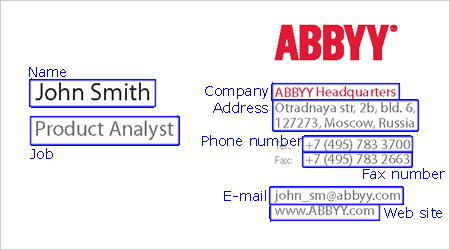Business Card Recognition
Business cards contain business information about a company or a person. Business cards can include a person's name, company, telephone numbers, fax, e-mail, website addresses, and similar information. You may need to capture this information from paper business cards and save it in electronic format. It can be an electronic address book of a mobile phone, e-mail client, or any other data storage system. For example, business cards are often passed by e-mail or network in vCard format.
The main steps which you need to perform in this scenario:
- Obtaining a digital copy of a business card
You either scan or take a photo of a business card. Photos made with digital cameras of mobile devices may have low resolution and quality. Thus additional preparation of the images may be required.
- Recognizing business cards
Scanned pages can contain several business cards per page. Recognition must have high quality; all information must be extracted accurately.
- Saving recognized data in a suitable format
You can save recognized data to different data storage systems, or export it to vCard format and pass by e-mail.
Implementing the scenario
Below follows a detailed description of the recommended method of using ABBYY FineReader Engine in this scenario.
Step 1. Loading ABBYY FineReader Engine
Step 2. Loading settings for the scenario
Step 3. Loading and preprocessing the images of business cards
Step 4. Recognizing business cards
Step 5. Working with recognized data
Step 6. Saving results in vCard format
Step 7. Unloading ABBYY FineReader Engine
Required resources
You can use the FREngineDistribution.csv file to automatically create a list of files required for your application to function. For processing with this scenario, select in the column 5 (RequiredByModule) the following values:
Core
Core.Resources
Opening
Opening, Processing
Processing
Processing.BCR
Processing.OCR
Processing.OCR, Processing.ICR
Processing.OCR.NaturalLanguages
Processing.OCR.NaturalLanguages, Processing.ICR.NaturalLanguages
Export
Export, Processing
If you modify the standard scenario, change the required modules accordingly. You also need to specify the interface languages, recognition languages and any additional features which your application uses (such as, e.g., Opening.PDF if you need to open PDF files, or Processing.OCR.CJK if you need to recognize texts in CJK languages). See Working with the FREngineDistribution.csv File for further details.
Additional optimization
These are the sections of the Help file where you can find additional information about setting up the parameters for the various processing stages:
- Loading Engine
- Working with Profiles
Provides detailed description of predefined and user profiles. - Opening and preprocessing images
- Image Preprocessing
Describes a scenario of using ABBYY FineReader Engine to preprocess images. - Recognition
- Tuning Parameters of Preprocessing, Analysis, Recognition, and Synthesis
Customization of document processing using objects of preprocessing, analysis, recognition, and synthesis parameters. - Export
- Tuning Export Parameters
Setting up export with the objects of export parameters. - XMLExportParams Object
This object allows you to set up the saving of recognition results to XML.
See also
7/3/2024 8:50:10 AM

